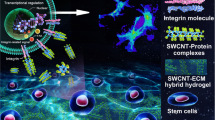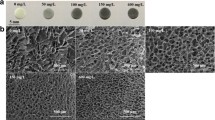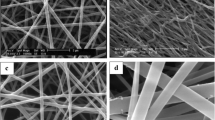Abstract
Tissue engineering offers a promising alternative therapy for myocardial infarction, which is associated with high mortality rates. Meanwhile, excellent biocompatibility and conductivity are indispensable features of cardiac tissue engineering scaffolds that facilitate electrical signal transmission between cardiomyocytes. In this study, 2,2,6,6-tetramethylpiperidine-1-oxy (TEMPO) -oxidized cellulose nanofibers (TOCN) were crosslinked by iron ions, then polymerized with pyrrole monomer to obtain in situ polymerized polypyrrole nanocellulose composite hydrogel scaffolds for myocardial tissue engineering. The composite hydrogel exhibited mechanical properties (50 ~ 75 kPa) and electrical conductivity (5 × 10–5 S·cm−1 ~ 1 × 10–3 S·cm−1) that match those of natural myocardial tissue, while it was non-cytotoxic (relative growth rate > 90%) and biocompatibility. At the same time, cells cultured on the TOCN-PPy scaffold showed increased expression of myocardial specific proteins such as connexin 43 and cardiac troponin T. Thus, the TOCN-PPy composite hydrogel showed a broad application prospect in the field of myocardial tissue engineering scaffold.
Graphical abstract









Similar content being viewed by others
Data availability
No datasets were generated or analysed during the current study.
References
Alamdari SG, Alibakhshi A, de la Guardia M, Baradaran B, Mohammadzadeh R, Amini M, Kesharwani P, Mokhtarzadeh A, Oroojalian F, Sahebkar A (2022) Conductive and semiconductive nanocomposite-based hydrogels for cardiac tissue engineering. Adv Healthc Mater 11(18):2200526. https://doi.org/10.1002/adhm.202200526
Amaral HR, Wilson JA, do Amaral RJFC, Pasçu I, de Oliveira FCS, Kearney CJ, Freitas JCC, Heise A (2021) Synthesis of bilayer films from regenerated cellulose nanofibers and poly(globalide) for skin tissue engineering applications. Carbohydr Polym 252:117201. https://doi.org/10.1016/j.carbpol.2020.117201
Ashtari K, Nazari H, Ko H, Tebon P, Akhshik M, Akbari M, Alhosseini SN, Mozafari M, Mehravi B, Soleimani M, Ardehali R, Ebrahimi Warkiani M, Ahadian S, Khademhosseini A (2019) Electrically conductive nanomaterials for cardiac tissue engineering. Adv Drug Deliv Rev 144:162–179. https://doi.org/10.1016/j.addr.2019.06.001
Babuin L (2005) Troponin: the biomarker of choice for the detection of cardiac injury. Can Med Assoc J 173(10):1191–1202. https://doi.org/10.1503/cmaj/051291
Basara G, Saeidi-Javash M, Ren X, Bahcecioglu G, Wyatt BC, Anasori B, Zhang Y, Zorlutuna P (2022) Electrically conductive 3D printed Ti3C2Tx MXene-PEG composite constructs for cardiac tissue engineering. Acta Biomater 139:179–189. https://doi.org/10.1016/j.actbio.2020.12.033
Chen P-H, Liao H-C, Hsu S-H, Chen R-S, Wu M-C, Yang Y-F, Wu C-C, Chen M-H, Su W-F (2015) A novel polyurethane/cellulose fibrous scaffold for cardiac tissue engineering. RSC Adv 5(9):6932–6939. https://doi.org/10.1039/c4ra12486c
Chen M, Tan H, Xu W, Wang Z, Zhang J, Li S, Zhou T, li J, Niu X, (2022) A self-healing, magnetic and injectable biopolymer hydrogel generated by dual cross-linking for drug delivery and bone repair. Acta Biomater 153:159–177. https://doi.org/10.1016/j.actbio.2022.09.036
Coulombe KLK, Bajpai VK, Andreadis ST, Murry CE (2014) Heart regeneration with engineered myocardial tissue. Annu Rev Biomed Eng 16(1):1–28. https://doi.org/10.1146/annurev-bioeng-071812-152344
Ding P, Liu Y, He X, Liu D, Chen M (2019) In vitro and in vivo biocompatibility of Mg-Zn-Ca alloy operative clip. Bioact Mater 4:236–244. https://doi.org/10.1016/j.bioactmat.2019.07.002
Domenech M, Polo-Corrales L, Ramirez-Vick JE, Freytes DO (2016) Tissue engineering strategies for myocardial regeneration: acellular versus cellular scaffolds? Tissue Eng Part B Rev 22(6):438–458. https://doi.org/10.1089/ten.teb.2015.0523
Duceac IA, Coseri S (2022) Biopolymers and their derivatives: key components of advanced biomedical technologies. Biotechnol Adv 61:108056. https://doi.org/10.1016/j.biotechadv.2022.108056
Engelmayr GC, Cheng M, Bettinger CJ, Borenstein JT, Langer R, Freed LE (2008) Accordion-like honeycombs for tissue engineering of cardiac anisotropy. Nat Mater 7(12):1003–1010. https://doi.org/10.1038/nmat2316
Esmaeili H, Patino-Guerrero A, Hasany M, Ansari MO, Memic A, Dolatshahi-Pirouz A, Nikkhah M (2022) Electroconductive biomaterials for cardiac tissue engineering. Acta Biomater 139:118–140. https://doi.org/10.1016/j.actbio.2021.08.031
Gao Y, Liu D, Xie Y, Song Y, Zhu E, Shi Z, Yang Q, Xiong C (2021) Flexible and sensitive piezoresistive electronic skin based on TOCN/PPy hydrogel films. J Appl Polym Sci 138(48). https://doi.org/10.1002/app.51367
Goodenough DA, Goliger JA, Paul DL (1996) Connexins, connexons, and intercellular communication. Annu Rev Biochem 65(1):475–502. https://doi.org/10.1146/annurev.bi.65.070196.002355
Gul K, Gan R-Y, Sun C-X, Jiao G, Wu D-T, Li H-B, Kenaan A, Corke H, Fang Y-P (2021) Recent advances in the structure, synthesis, and applications of natural polymeric hydrogels. Crit Rev Food Sci Nutr 62(14):3817–3832. https://doi.org/10.1080/10408398.2020.1870034
Guo L, Liang Z, Yang L, Du W, Yu T, Tang H, Li C, Qiu H (2021) The role of natural polymers in bone tissue engineering. J Control Release 338:571–582. https://doi.org/10.1016/j.jconrel.2021.08.055
Hahn J-Y, Cho H-J, Kang H-J, Kim T-S, Kim M-H, Chung J-H, Bae J-W, Oh B-H, Park Y-B, Kim H-S (2008) Pre-treatment of mesenchymal stem cells with a combination of growth factors enhances gap junction formation, cytoprotective effect on cardiomyocytes, and therapeutic efficacy for myocardial infarction. J Am Coll Cardiol 51(9):933–943. https://doi.org/10.1016/j.jacc.2007.11.040
Hazra RS, Kale N, Boyle C, Molina KB, D’Souza A, Aland G, Jiang L, Chaturvedi P, Ghosh S, Mallik S, Khandare J, Quadir M (2024) Magnetically-activated, nanostructured cellulose for efficient capture of circulating tumor cells from the blood sample of head and neck cancer patients. Carbohydr Polym 323:121418. https://doi.org/10.1016/j.carbpol.2023.121418
Incani V, Danumah C, Boluk Y (2013) Nanocomposites of nanocrystalline cellulose for enzyme immobilization. Cellulose 20(1):191–200. https://doi.org/10.1007/s10570-012-9805-2
Isogai A, Hänninen T, Fujisawa S, Saito T (2018) Review: Catalytic oxidation of cellulose with nitroxyl radicals under aqueous conditions. Prog Polym Sci 86:122–148. https://doi.org/10.1016/j.progpolymsci.2018.07.007
Kai D, Prabhakaran MP, Jin G, Ramakrishna S (2011) Polypyrrole-contained electrospun conductive nanofibrous membranes for cardiac tissue engineering. J Biomed Mater Res A 99A(3):376–385. https://doi.org/10.1002/jbm.a.33200
Kazemi Asl S, Rahimzadegan M, Ostadrahimi R (2023) The recent advancement in the chitosan hybrid-based scaffolds for cardiac regeneration after myocardial infarction. Carbohydr Polym 300:120266. https://doi.org/10.1016/j.carbpol.2022.120266
Langer R, Vacanti JP (1993) Tissue engineering. Science 260(5110):920–926. https://doi.org/10.1126/science.8493529
Li Y, Yu H, Zhang Y, Zhou N, Tan Z (2022) Kinetics and characterization of preparing conductive nanofibrous membrane by in-situ polymerization of polypyrrole on electrospun nanofibers. Chem Eng J 433:133531. https://doi.org/10.1016/j.cej.2021.133531
Li G, Gao Y, Sun C, Niu F, Shi Z, Yang Q, Xiong C (2024) An anti-freezing and anti-drying nanocellulose hydrogel for human motion detection. Colloids Surf A 683:133055. https://doi.org/10.1016/j.colsurfa.2023.133055
Liang Y, Mitriashkin A, Lim TT, Goh JCH (2021) Conductive polypyrrole-encapsulated silk fibroin fibers for cardiac tissue engineering. Biomaterials 276:121008. https://doi.org/10.1016/j.biomaterials.2021.121008
Liao M, Wan P, Wen J, Gong M, Wu X, Wang Y, Shi R, Zhang L (2017) Wearable, healable, and adhesive epidermal sensors assembled from mussel-inspired conductive hybrid hydrogel framework. Adv Funct Mater 27(48):1703852. https://doi.org/10.1002/adfm.201703852
Liu Q, Tian S, Zhao C, Chen X, Lei I, Wang Z, Ma PX (2015) Porous nanofibrous poly(l-lactic acid) scaffolds supporting cardiovascular progenitor cells for cardiac tissue engineering. Acta Biomater 26:105–114. https://doi.org/10.1016/j.actbio.2015.08.017
Liu Z, Chen J, Zhan Y, Liu B, Xiong C, Yang Q, Hu GH (2019a) Fe3+ cross-linked polyaniline/cellulose nanofibril hydrogels for high-performance flexible solid-state supercapacitors. ACS Sustain Chem Eng 7(21):17653–17660. https://doi.org/10.1021/acssuschemeng.9b03674
Liu X, Qu J, Wang A, Wang C, Chen B, Wang Z, Wu B, Wei B, Wen Y, Yuan Z (2019b) Hydrogels prepared from cellulose nanofibrils via ferric ion-mediated crosslinking reaction for protecting drilling fluid. Carbohydr Polym 212:67–74. https://doi.org/10.1016/j.carbpol.2019.02.036
Liu D, Gao Y, Song Y, Zhu H, Zhang L, Xie Y, Shi H, Shi Z, Yang Q, Xiong C (2021) Highly sensitive multifunctional electronic skin based on nanocellulose/MXene composite films with good electromagnetic shielding biocompatible antibacterial properties. Biomacromolecules 23(1):182–195. https://doi.org/10.1021/acs.biomac.1c01203
Liu J, Cheng F, Grénman H, Spoljaric S, Seppälä J, Eriksson JE, Willför S, Xu C (2016) Development of nanocellulose scaffolds with tunable structures to support 3D cell culture. Carbohydr Polym 148:259–271. https://doi.org/10.1016/j.carbpol.2016.04.064
Lu Y, Han J, Ding Q, Yue Y, Xia C, Ge S, Van Le Q, Dou X, Sonne C, Lam SS (2021) TEMPO-oxidized cellulose nanofibers/polyacrylamide hybrid hydrogel with intrinsic self-recovery and shape memory properties. Cellulose 28(3):1469–1488. https://doi.org/10.1007/s10570-020-03606-8
Luo H, Cha R, Li J, Hao W, Zhang Y, Zhou F (2019) Advances in tissue engineering of nanocellulose-based scaffolds: a review. Carbohydr Polym 224:115144. https://doi.org/10.1016/j.carbpol.2019.115144
Maharjan B, Kumar D, Awasthi GP, Bhattarai DP, Kim JY, Park CH, Kim CS (2019) Synthesis and characterization of gold/silica hybrid nanoparticles incorporated gelatin methacrylate conductive hydrogels for H9C2 cardiac cell compatibility study. Compos B Eng 177:107415. https://doi.org/10.1016/j.compositesb.2019.107415
Messina E, De Angelis L, Frati G, Morrone S, Chimenti S, Fiordaliso F, Salio M, Battaglia M, Latronico MVG, Coletta M, Vivarelli E, Frati L, Cossu G, Giacomello A (2004) Isolation and expansion of adult cardiac stem cells from human and murine heart. Circ Res 95(9):911–921. https://doi.org/10.1161/01.res.0000147315.71699.51
Navaei A, Saini H, Christenson W, Sullivan RT, Ros R, Nikkhah M (2016) Gold nanorod-incorporated gelatin-based conductive hydrogels for engineering cardiac tissue constructs. Acta Biomater 41:133–146. https://doi.org/10.1016/j.actbio.2016.05.027
O’Brien FJ (2011) Biomaterials & scaffolds for tissue engineering. Mater Today 14(3):88–95. https://doi.org/10.1016/s1369-7021(11)70058-x
Ren J, Xu Q, Chen X, Li W, Guo K, Zhao Y, Wang Q, Zhang Z, Peng H, Li Y-G (2017) Superaligned carbon nanotubes guide oriented cell growth and promote electrophysiological homogeneity for synthetic cardiac tissues. Adv Mater 29(44):1702713. https://doi.org/10.1002/adma.201702713
Roshanbinfar K, Vogt L, Ruther F, Roether JA, Boccaccini AR, Engel FB (2019) Nanofibrous composite with tailorable electrical and mechanical properties for cardiac tissue engineering. Adv Funct Mater 30(7):1908612. https://doi.org/10.1002/adfm.201908612
Ruvinov E, Cohen S (2016) Alginate biomaterial for the treatment of myocardial infarction: Progress, translational strategies, and clinical outlook: from ocean algae to patient bedside. Adv Drug Deliv Rev 96:54–76. https://doi.org/10.1016/j.addr.2015.04.021
Serafin A, Murphy C, Rubio MC, Collins MN (2021) Printable alginate/gelatin hydrogel reinforced with carbon nanofibers as electrically conductive scaffolds for tissue engineering. Mater Sci Eng C 122:111927. https://doi.org/10.1016/j.msec.2021.111927
Shahriari-Khalaji M, Li G, Liu L, Sattar M, Chen L, Zhong C, Hong FF (2022) A poly-L-lysine-bonded TEMPO-oxidized bacterial nanocellulose-based antibacterial dressing for infected wound treatment. Carbohydr Polym 287:119266. https://doi.org/10.1016/j.carbpol.2022.119266
Shan C, Che M, Cholewinski A, Kunihiro JKI, Yim EKF, Su R, Zhao B (2022) Adhesive hydrogels tailored with cellulose nanofibers and ferric ions for highly sensitive strain sensors. Chem Eng J 450:138256. https://doi.org/10.1016/j.cej.2022.138256
Shapira A, Feiner R, Dvir T (2016) Composite biomaterial scaffolds for cardiac tissue engineering. Int Mater Rev 61(1):1–19. https://doi.org/10.1179/1743280415y.0000000012
Sheikhi A, Hayashi J, Eichenbaum J, Gutin M, Kuntjoro N, Khorsandi D, Khademhosseini A (2019) Recent advances in nanoengineering cellulose for cargo delivery. J Control Release 294:53–76. https://doi.org/10.1016/j.jconrel.2018.11.024
Shi Z, Gao X, Ullah MW, Li S, Wang Q, Yang G (2016) Electroconductive natural polymer-based hydrogels. Biomaterials 111:40–54. https://doi.org/10.1016/j.biomaterials.2016.09.020
Shi M, Bai L, Xu M, Li Z, Hu T, Hu J, Zhang Z, Yin Z, Guo B (2022) Micropatterned conductive elastomer patch based on poly(glycerol sebacate)-graphene for cardiac tissue repair. Biofabrication 14(3):035001. https://doi.org/10.1088/1758-5090/ac59f2
Shiekh PA, Singh A, Kumar A (2018) Engineering bioinspired antioxidant materials promoting cardiomyocyte functionality and maturation for tissue engineering application. ACS Appl Mater Interfaces 10(4):3260–3273. https://doi.org/10.1021/acsami.7b14777
Shin SR, Zihlmann C, Akbari M, Assawes P, Cheung L, Zhang K, Manoharan V, Zhang YS, Yüksekkaya M, Wan K, Nikkhah M, Dokmeci MR, Tang XS, Khademhosseini A (2016) Reduced graphene oxide-GelMA hybrid hydrogels as scaffolds for cardiac tissue engineering. Small 12(27):3677–3689. https://doi.org/10.1002/smll.201600178
Song C, Zhang X, Wang L, Wen F, Xu K, Xiong W, Li C, Li B, Wang Q, Xing MM, Qiu X (2019a) An injectable conductive three-dimensional elastic network by tangled surgical-suture spring for heart repair. ACS Nano 13(12):14122–14137. https://doi.org/10.1021/acsnano.9b06761
Song X, Mei J, Ye G, Wang L, Ananth A, Yu L, Qiu X (2019b) In situ PPy-modification of chitosan porous membrane from mussel shell as a cardiac patch to repair myocardial infarction. Appl Mater Today 15:87–99. https://doi.org/10.1016/j.apmt.2019.01.003
Song Y, Shi Z, Hu G-H, Xiong C, Isogai A, Yang Q (2021) Recent advances in cellulose-based piezoelectric and triboelectric nanogenerators for energy harvesting: A review. J Mater Chem A 9(4):1910–1937. https://doi.org/10.1039/d0ta08642h
Song Y, Bao J, Hu Y, Xu M, Yang Z, Liu Y, Yang Q, Xiong C, Shi Z (2022a) Ultra-porous cellulose nanofibril aerogel films as excellent triboelectric positive materials via direct freeze-drying of dispersion. Nano Energy 103:107832. https://doi.org/10.1016/j.nanoen.2022.107832
Song Y, Liu M, Bao J, Hu Y, Xu M, Yang Z, Yang Q, Cai H, Xiong C, Shi Z (2022b) TOCN/copper calcium titanate composite aerogel films as high-performance triboelectric materials for energy harvesting. Carbohydr Polym 298:120111. https://doi.org/10.1016/j.carbpol.2022.120111
Song Y, Wu T, Bao J, Xu M, Yang Q, Zhu L, Shi Z, Hu G-H, Xiong C (2022c) Porous cellulose composite aerogel films with super piezoelectric properties for energy harvesting. Carbohydr Polym 288:119407. https://doi.org/10.1016/j.carbpol.2022.119407
Stratton S, Shelke NB, Hoshino K, Rudraiah S, Kumbar SG (2016) Bioactive polymeric scaffolds for tissue engineering. Bioact Mater 1(2):93–108. https://doi.org/10.1016/j.bioactmat.2016.11.001
Teodorescu M, Bercea M, Morariu S (2018) Biomaterials of poly(vinyl alcohol) and natural polymers. Polym Rev 58(2):247–287. https://doi.org/10.1080/15583724.2017.1403928
Tie J, Chai H, Mao Z, Zhang L, Zhong Y, Sui X, Xu H (2021) Nanocellulose-mediated transparent high-strength conductive hydrogel based on in-situ formed polypyrrole nanofibrils as a multimodal sensor. Carbohydr Polym 273:118600. https://doi.org/10.1016/j.carbpol.2021.118600
Tu CW, Tsai FC, Chen JK, Wang HP, Lee RH, Zhang J, Chen T, Wang CC, Huang CF (2020) Preparations of tough and conductive PAMPS/PAA double network hydrogels containing cellulose nanofibers and polypyrroles. Polymers 12(12):2835. https://doi.org/10.3390/polym12122835
Vogt L, Rivera LR, Liverani L, Piegat A, El Fray M, Boccaccini AR (2019) Poly(ε-caprolactone)/poly(glycerol sebacate) electrospun scaffolds for cardiac tissue engineering using benign solvents. Mater Sci Eng C 103:109712. https://doi.org/10.1016/j.msec.2019.04.091
Wang Y, Wang X, Xie Y, Zhang K (2018) Functional nanomaterials through esterification of cellulose: A review of chemistry and application. Cellulose 25(7):3703–3731. https://doi.org/10.1007/s10570-018-1830-3
Wang K, Hazra RS, Ma Q, Khan MR, Al Hoque A, Jiang L, Quadir M, Zhang Y, Wang S, Han G (2023) Robust biocompatible bacterial cellulose/silk nonwoven fabric/silk sericin sandwich membrane with strong UV-blocking and antioxidant properties. Cellulose 30(6):3973–3993. https://doi.org/10.1007/s10570-023-05102-1
Wu S, Li Y, Zhang C, Tao L, Kuss M, Lim JY, Butcher J, Duan B (2022) Tri-layered and gel-like nanofibrous scaffolds with anisotropic features for engineering heart valve leaflets. Adv Healthcare Mater 11(10):2200053. https://doi.org/10.1002/adhm.202200053
Xie Y, Xu H, He X, Hu Y, Zhu E, Gao Y, Liu D, Shi Z, Li J, Yang Q, Xiong C (2020) Flexible electronic skin sensor based on regenerated cellulose/carbon nanotube composite films. Cellulose 27(17):10199–10211. https://doi.org/10.1007/s10570-020-03496-w
Xu H, Liu Y, Xie Y, Zhu E, Shi Z, Yang Q, Xiong C (2019) Doubly cross-linked nanocellulose hydrogels with excellent mechanical properties. Cellulose 26(16):8645–8654. https://doi.org/10.1007/s10570-019-02689-2
Xu H, Xie Y, Zhu E, Liu Y, Shi Z, Xiong C, Yang Q (2020) Supertough and ultrasensitive flexible electronic skin based on nanocellulose/sulfonated carbon nanotube hydrogel films. J Mater Chem A 8(13):6311–6318. https://doi.org/10.1039/d0ta00158a
Xu Q, Torres JE, Hakim M, Babiak PM, Pal P, Battistoni CM, Nguyen M, Panitch A, Solorio L, Liu JC (2021) Collagen and hyaluronic acid-based hydrogels and their biomedical applications. Mater Sci Eng R Rep 146:100641. https://doi.org/10.1016/j.mser.2021.100641
Xu H, Liu D, Song Y, Xie Y, Shi Z, Xiong C, Yang Q (2022) Ultra-sensitive and flexible electronic skin from nanocellulose/AgNWs hydrogel films with highly transparent, antibacterial and electromagnetic shielding properties. Compos Sci Technol 228:109679. https://doi.org/10.1016/j.compscitech.2022.109679
Zhan Y, Hu Y, Chen Y, Yang Q, Shi Z, Xiong C (2021) In-situ synthesis of flexible nanocellulose/carbon nanotube/polypyrrole hydrogels for high-performance solid-state supercapacitors. Cellulose 28(11):7097–7108. https://doi.org/10.1007/s10570-021-03998-1
Zhang J, Calafiore M, Zeng Q, Zhang X, Huang Y, Li RA, Deng W, Zhao M (2011) Electrically guiding migration of human induced pluripotent stem cells. Stem Cell Rev Rep 7(4):987–996. https://doi.org/10.1007/s12015-011-9247-5
Zhang H, Guo J, Wang Y, Shang L, Chai R, Zhao Y (2022) Natural polymer-derived bioscaffolds for peripheral nerve regeneration. Adv Funct Mater 32(41):2203829. https://doi.org/10.1002/adfm.202203829
Zhou J, Chen J, Sun H, Qiu X, Mou Y, Liu Z, Zhao Y, Li X, Han Y, Duan C, Tang R, Wang C, Zhong W, Liu J, Luo Y, Xing M, Wang C (2014) Engineering the heart: Evaluation of conductive nanomaterials for improving implant integration and cardiac function. Sci Rep 4(1). https://doi.org/10.1038/srep03733
Zhu E, Xu H, Xie Y, Song Y, Liu D, Gao Y, Shi Z, Yang Q, Xiong C (2021) Antifreezing ionotronic skin based on flexible, transparent, and tunable ionic conductive nanocellulose hydrogels. Cellulose 28:5657–5668. https://doi.org/10.1007/s10570-021-03878-8
Zhu H, Zhu E, Xie Y, Liu D, Hu Y, Shi Z, Xiong C, Yang Q (2022a) Hydrangea-like nanocellulose microspheres with high dye adsorption and drug encapsulation prepared by emulsion method. Carbohydr Polym 296:119947. https://doi.org/10.1016/j.carbpol.2022.119947
Zhu S, Yu C, Liu N, Zhao M, Chen Z, Liu J, Li G, Huang H, Guo H, Sun T, Chen J, Zhuang J, Zhu P (2022b) Injectable conductive gelatin methacrylate/oxidized dextran hydrogel encapsulating umbilical cord mesenchymal stem cells for myocardial infarction treatment. Bioact Mater 13:119–134. https://doi.org/10.1016/j.bioactmat.2021.11.011
Acknowledgments
The research was supported by the Shandong Provincial Natural Science Foundation of China (No. ZR202103020328).
Funding
The research was supported by the Shandong Provincial Natural Science Foundation of China (No. ZR202103020328).
Author information
Authors and Affiliations
Contributions
R. H. : Writing - original draft, Investigation, Methodology, Formal analysis. Y. X. : Writing - review & editing, Validation, Investigation, Data curation, Visualization. R. S. : Investigation. J. B. : Investigation. Z. S: Conceptualization, Methodology, Project administration, Writing - review & editing, Supervision. C. X. : Writing - review & editing. All authors reviewed the manuscript. Q. Y. : Investigation, Writing - review & editing.
Corresponding authors
Ethics declarations
Ethical approval
Not applicable.
Competing interests
The authors declare no competing interests.
Additional information
Publisher's Note
Springer Nature remains neutral with regard to jurisdictional claims in published maps and institutional affiliations.
Supplementary Information
Below is the link to the electronic supplementary material.
Rights and permissions
Springer Nature or its licensor (e.g. a society or other partner) holds exclusive rights to this article under a publishing agreement with the author(s) or other rightsholder(s); author self-archiving of the accepted manuscript version of this article is solely governed by the terms of such publishing agreement and applicable law.
About this article
Cite this article
Hou, R., Xie, Y., Song, R. et al. Nanocellulose/polypyrrole hydrogel scaffolds with mechanical strength and electrical activity matching native cardiac tissue for myocardial tissue engineering. Cellulose (2024). https://doi.org/10.1007/s10570-024-05874-0
Received:
Accepted:
Published:
DOI: https://doi.org/10.1007/s10570-024-05874-0




